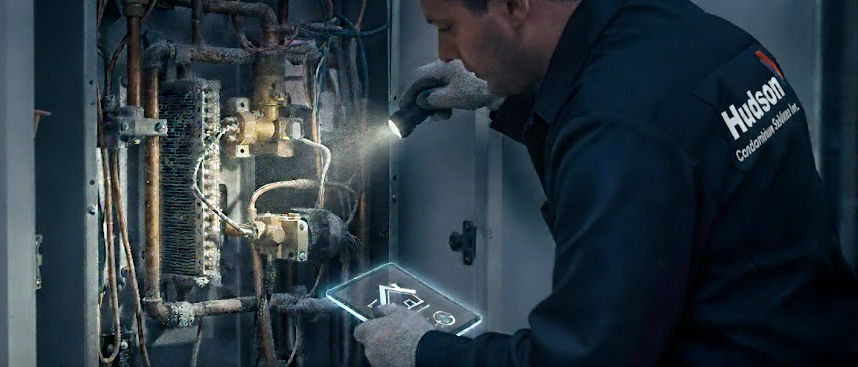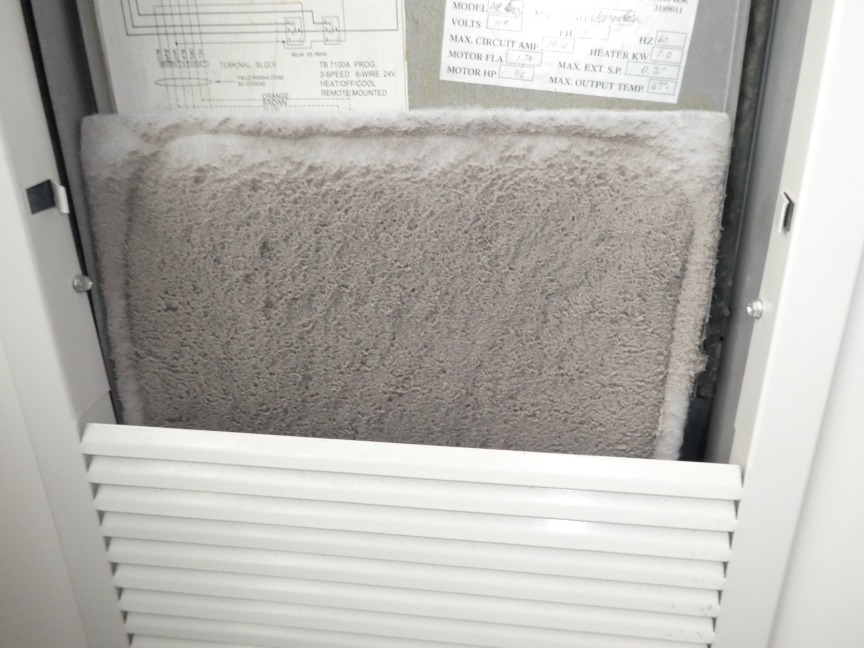Toronto Condo AC Not Heating? Here’s Why Your Fan Coil or Heat Pump Is Likely Broken
Is your Toronto condo not heating? Learn the top reasons your fan coil or heat pump isn’t heating, what it means, and how to fix no-heat issues fast.
- Hudson HVAC
- 7 min read

Toronto Condo AC Not Heating? Here’s Why Your Fan Coil or Heat Pump Is Likely Broken
If your Toronto condo isn’t producing heat, you’re not alone. Every fall and winter, thousands of condo residents across Toronto, Mississauga, Etobicoke, and North York report the same issue:
“My condo isn’t heating — is my fan coil or heat pump broken?”
In most cases: yes, something inside the suite has failed.
Whether your unit uses a fan coil or water-source heat pump, most no-heat problems in Toronto condos come down to a small set of predictable mechanical failures.
This guide explains the most common breakdowns, what they mean, and what repairs are needed to get your heating running again.
Understanding Toronto Condo HVAC (Why It’s Different)
Toronto condos do not use furnaces. Instead, they rely on:
- Central building heating systems
- In-suite equipment (fan coils or heat pumps)
- Shared water loops
- Seasonal heating/cooling changeovers
This means:
- Your thermostat does not control the entire system
- Heat depends on the building’s mode and loop temperature
- In-suite failures are extremely common
- Many systems are 15–30 years old and wearing out
Most “no heat” problems are inside the suite, not the building.
1. Failed or Stuck Heating Valve (Most Common Cause)
In a fan coil system, a hydronic heating valve opens to let hot water into your coil. When it fails, your condo will not heat, even if the building is in heating mode.
What This Means
A failed heating valve means that hot water cannot enter your coil, so the fan coil will continue blowing cold or room-temperature air even if the thermostat is calling for heat. You may notice the fan running continuously with no temperature increase, or the suite may feel increasingly cold as the day progresses. Because the valve is a mechanical device, it cannot fix itself — once stuck or burnt out, the unit will never heat until the valve is repaired or replaced.
Required Repair
To fix this issue, a technician must diagnose whether the problem is the actuator or the valve body itself. The repair typically involves testing the actuator, freeing or exercising the valve, replacing the actuator if the motor has burnt out, or replacing the entire valve assembly if it is seized internally. After the repair, the technician must verify that hot water is flowing and confirm proper temperature rise to ensure heating has been fully restored.
2. Dirty or Blocked Fan Coil (Clogged Coil or Blower Wheel)
A dirty fan coil cannot transfer heat, even if the heating valve works perfectly.
What This Means
When the internal coil or blower wheel is covered in dust, lint, or construction debris, airflow drops significantly. This reduces or eliminates heat production because warm water in the coil cannot efficiently transfer heat into the air. As a result, you may feel weak airflow, lukewarm air, or even a burning smell from overheating components. Over time, this strain can lead to motor failure or safety shutdowns, turning a simple cleaning issue into a larger repair.
Required Repair
The solution is a full fan coil service, which includes deep cleaning the coil, cleaning or decontaminating the blower wheel, replacing the filter, flushing the drain pan, and lubricating the motor where applicable. Technicians will also test temperature rise to ensure the air is heating properly after airflow is restored.
3. Heat Pump Reversing Valve Failure
A water-source heat pump uses a reversing valve to switch between heating and cooling. If it fails, the unit cannot enter heating mode.
What This Means
When the reversing valve fails, your heat pump becomes “stuck” in cooling mode, regardless of what the thermostat requests. The system may blow cold air, make a loud humming noise, or cycle on and off without producing heat. This issue will not resolve on its own — the internal components responsible for directional refrigerant flow are no longer functioning correctly, preventing the heat pump from generating warmth.
Required Repair
Repairing this issue requires a trained technician to test the reversing valve solenoid, inspect all electrical connections, determine whether the valve is stuck mechanically, and replace the reversing valve if necessary. After replacement, the technician must verify refrigerant charge, test full heating mode, and confirm proper cycle operation.
4. Failed Blower Motor or Capacitor
Even if heat is available, a failed blower motor or capacitor prevents warm air from reaching your suite.
What This Means
A broken blower motor means that the fan cannot push heated air into the condo. The unit may hum, click, or attempt to start before shutting down. You may hear the thermostat click on, but no air will move through the vents. In other cases, the airflow may be extremely weak due to the motor overheating or stalling. Without airflow, the unit cannot heat your condo at all, even if the coil is hot.
Required Repair
Fixing this issue typically involves replacing the blower motor, replacing the capacitor (a common failure point), balancing the blower wheel, and testing electrical load and amperage draw. After the repair, the technician verifies that all fan speeds work correctly and that airflow meets expected levels.
5. Thermostat or Control Board Failure
A thermostat failure often appears like a heating failure, but the problem is electrical communication — not heating capacity.
What This Means
If the thermostat or control board cannot properly signal the fan coil or heat pump to enter heating mode, the unit will not respond even though heat is available. You may notice unresponsive temperature changes, incorrect readings, loss of fan speeds, or intermittent system behavior. The system may run but never heat, or fail to turn on at all.
Required Repair
The repair may involve replacing the thermostat, rewiring low-voltage connections, repairing the control board, or resetting communication between components. Afterward, the technician tests all modes to ensure proper heating, cooling, and fan operation.
6. Coil Frozen (Yes, Even in Heating Season)
Restricted airflow or refrigerant issues can cause a coil to freeze, even during winter.
What This Means
When airflow is inadequate or refrigerant levels are low, the coil temperature drops below freezing, forming ice inside the unit. This ice blocks airflow entirely, meaning no warm air can circulate. You may experience low airflow, dripping water, or a complete system shutdown. Left untreated, a frozen coil can cause significant mechanical damage.
Required Repair
The technician must defrost the coil, repair the airflow or refrigerant issue, inspect the blower motor and filter, and verify that the unit runs without freezing again. Running the unit while frozen can damage the compressor and should be avoided.
7. Building Loop Problems (Less Common)
Occasionally, the issue is building-wide: a boiler issue, loop pump failure, or airlock in a hydronic system.
What This Means
When the building’s loop temperature is low or circulation pumps are down, no suite can receive proper heating. Your individual unit may be functioning correctly, but without hot water circulating through the system, you will not feel heat.
Required Repair
The building’s mechanical contractor must restart pumps, purge air, reset boilers, or adjust loop temperature. If neighbours have heat and you don’t, the issue is inside your suite — not the building.
Warning Signs Before Complete Failure
Common early symptoms include:
- Burning smell from the unit
- Water pooling around the fan coil
- Loud buzzing or humming
- Breaker tripping
- Unit running constantly without heating
- Musty or mouldy smells
These are early signs of valve failure, blower issues, or coil blockage — and should be inspected immediately.
Need Fast Condo Heating Repair in Toronto? Hudson Can Fix Your Fan Coil or Heat Pump Today.
If your Toronto condo isn’t producing heat, you don’t need to wait days for help. Hudson specializes exclusively in Toronto and GTA condo HVAC systems, including fan coil units, water-source heat pumps, heating valves, actuators, blower motors, reversing valves, and frozen or blocked coils. Our technicians are trained specifically for high-rise in-suite equipment, meaning we diagnose and repair no-heat issues faster and more accurately than general HVAC companies.
We offer same-day service across Toronto, Mississauga, Etobicoke, North York, Scarborough, Brampton, and more!
Contact Hudson to restore heating in Toronto condos:
- 🌐 Website: hudsonhvac.ca
- ✉️ Email: service@hudsonhvac.ca
- 📍 Based in downtown Toronto, serving condominium communities across the GTA
Hudson is the trusted HVAC contractor for thousands of Toronto condo residents and multiple property management firms. If your fan coil or heat pump isn’t heating, we’ll get your home warm again — fast.
- Tags:
- Toronto Condo No Heat
- Condo AC Not Heating
- Toronto Condo HVAC
- Fan Coil Not Heating Toronto
- Heat Pump No Heat Toronto
- Condo Heating Repair Toronto
- Fan Coil Repair
- Toronto HVAC Emergency
- Condo Heat Not Working
- Why Is My Condo Cold
- Toronto Fan Coil Maintenance
- Water Source Heat Pump Repair
- Condo HVAC Troubleshooting



